-2024届高三英语二轮复习被动语态课件(共14张PPT)
文档属性
| 名称 | -2024届高三英语二轮复习被动语态课件(共14张PPT) |  | |
| 格式 | pptx | ||
| 文件大小 | 319.1KB | ||
| 资源类型 | 教案 | ||
| 版本资源 | 通用版 | ||
| 科目 | 英语 | ||
| 更新时间 | 2023-11-11 16:47:52 | ||
图片预览

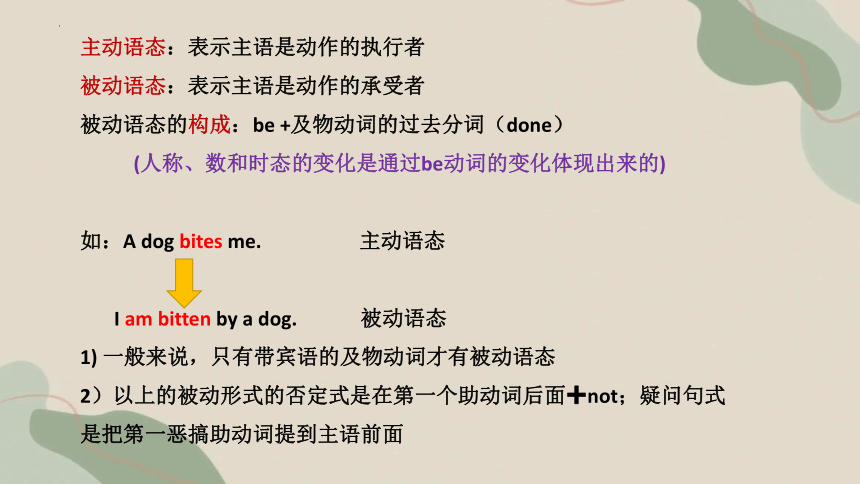
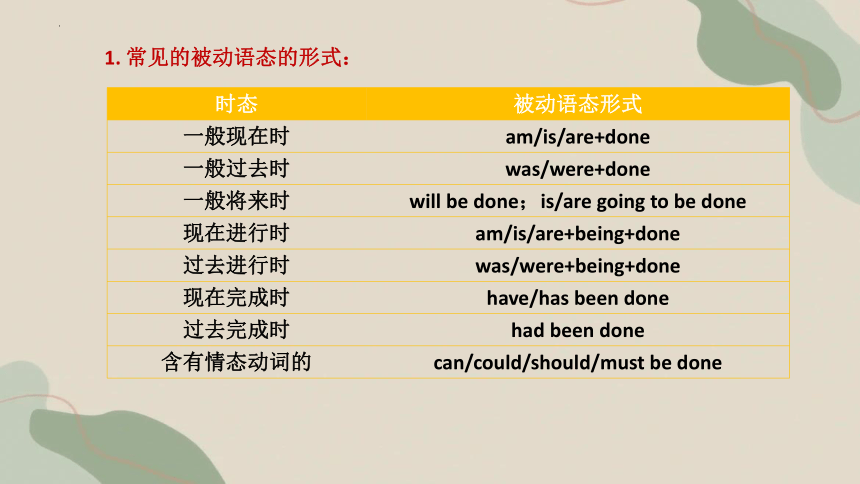
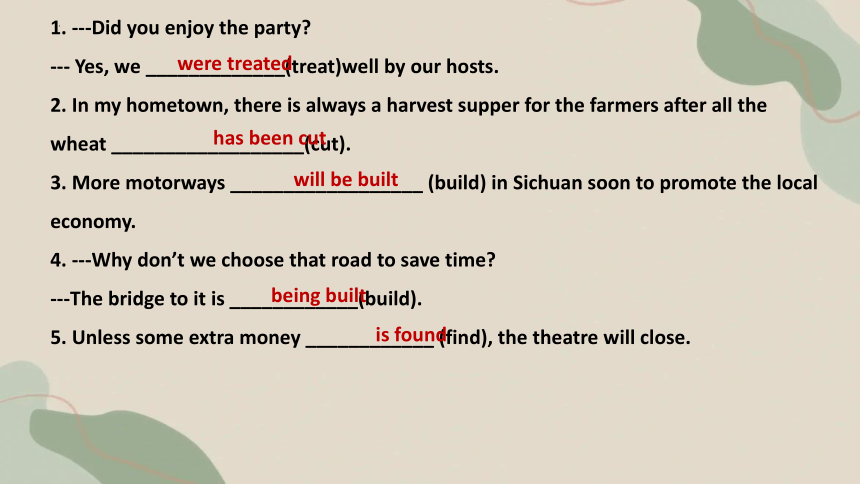
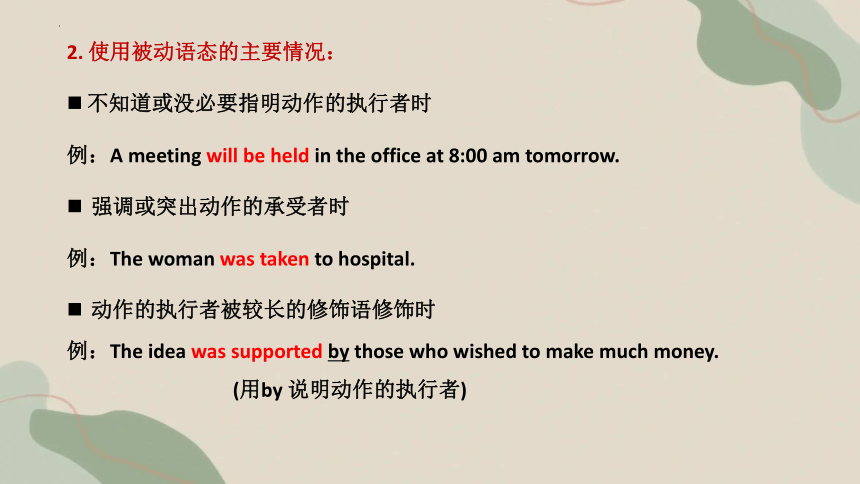
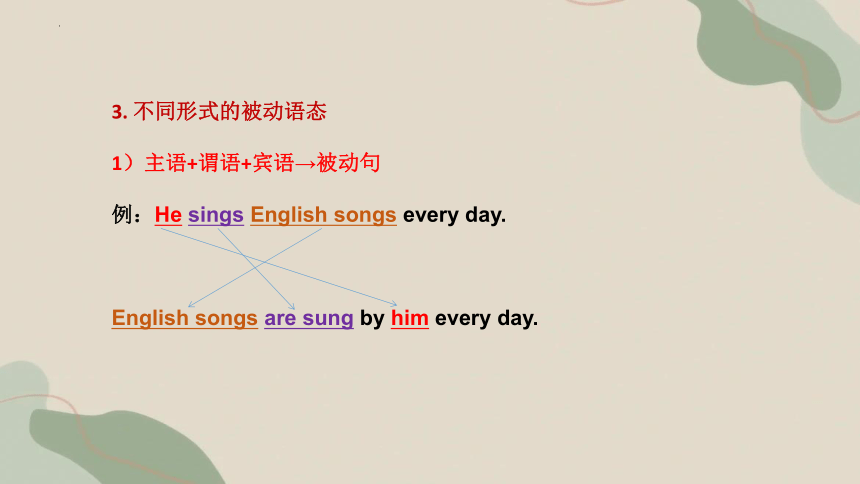

文档简介
(共14张PPT)
语法---被动语态
主动语态:表示主语是动作的执行者
被动语态:表示主语是动作的承受者
被动语态的构成:be +及物动词的过去分词(done)
(人称、数和时态的变化是通过be动词的变化体现出来的)
如:A dog bites me. 主动语态
I am bitten by a dog. 被动语态
1) 一般来说,只有带宾语的及物动词才有被动语态
2)以上的被动形式的否定式是在第一个助动词后面 not;疑问句式是把第一恶搞助动词提到主语前面
1. 常见的被动语态的形式:
时态 被动语态形式
一般现在时 am/is/are+done
一般过去时 was/were+done
一般将来时 will be done;is/are going to be done
现在进行时 am/is/are+being+done
过去进行时 was/were+being+done
现在完成时 have/has been done
过去完成时 had been done
含有情态动词的 can/could/should/must be done
1. ---Did you enjoy the party
--- Yes, we _____________(treat)well by our hosts.
2. In my hometown, there is always a harvest supper for the farmers after all the wheat __________________(cut).
3. More motorways __________________ (build) in Sichuan soon to promote the local economy.
4. ---Why don’t we choose that road to save time
---The bridge to it is ____________(build).
5. Unless some extra money ____________ (find), the theatre will close.
is found
were treated
has been cut
will be built
being built
2. 使用被动语态的主要情况:
不知道或没必要指明动作的执行者时
例:A meeting will be held in the office at 8:00 am tomorrow.
强调或突出动作的承受者时
例:The woman was taken to hospital.
动作的执行者被较长的修饰语修饰时
例:The idea was supported by those who wished to make much money.
(用by 说明动作的执行者)
3. 不同形式的被动语态
1)主语+谓语+宾语→被动句
例:He sings English songs every day.
English songs are sung by him every day.
2) 主语+谓语+间接宾语+直接宾语→被动句
give、send、take、bring 等常带有两个宾语,变成被动语态时,如果直接宾语遍被动句的主语时,被保留的间接宾语前通常 to
主动:The villagers gave the foreign guests a warm welcome.
被动1:The foreign guests were given a warm welcome.
被动2:A warm welcome was given to the foreign guests by the villagers.
2) 主语+谓语+间接宾语+直接宾语→被动句
buy、make 、find、get 等被保留的间接宾语前通常 for且不能省略
主动:I bought my wife a dress.
被动1:A dress was bought for my wife by me.
My wife was bought a dress for me. (×)
3) 主语+谓语+宾语+宾部→被动句
感官动词/使役动词省略to的不定式做宾语补足语在变被动句时要 to
例:I heard her move around in her upstairs room last night.
变被动:She was heard to move around in her upstairs room last night.
4) 动词短语变被动,其中的介词/副词不能丢
动词短语:look after、take up、look down on、take care of、make use of 等
例:The plan will be given up.
I must take good care of the little baby.
变被动:The little baby must be taken good care of (by me).
4. 主动形式表被动意义:
1)sth want/ need/ require +doing 某事需要做
sth be worth +doing 某事值得做
例:The flowers want watering.花儿需要浇水
The idea is worth considering. 这个想法值得考虑
4. 主动形式表被动意义:
2)感官动词,如 sound, taste, smell, feel, look 的主语是物时,用主动形式表示被动意义。
例:The ice cream tastes good.
后跟形容词作表语
4. 主动形式表被动意义:
3)表示事物本身的性质,主动形式表被动意义,如write,sell,wash,cut 等
例:This kind of knife is quite popular with customers, for it _____(cut) well.
cut
5. 被动语态的常见句型:(写作必备)
据说:It is said that...
据报道:It is reported that...
大家相信:It is believed that...
众所周知:It is well known that...
应该做某事:be sopposed to do sth
语法---被动语态
主动语态:表示主语是动作的执行者
被动语态:表示主语是动作的承受者
被动语态的构成:be +及物动词的过去分词(done)
(人称、数和时态的变化是通过be动词的变化体现出来的)
如:A dog bites me. 主动语态
I am bitten by a dog. 被动语态
1) 一般来说,只有带宾语的及物动词才有被动语态
2)以上的被动形式的否定式是在第一个助动词后面 not;疑问句式是把第一恶搞助动词提到主语前面
1. 常见的被动语态的形式:
时态 被动语态形式
一般现在时 am/is/are+done
一般过去时 was/were+done
一般将来时 will be done;is/are going to be done
现在进行时 am/is/are+being+done
过去进行时 was/were+being+done
现在完成时 have/has been done
过去完成时 had been done
含有情态动词的 can/could/should/must be done
1. ---Did you enjoy the party
--- Yes, we _____________(treat)well by our hosts.
2. In my hometown, there is always a harvest supper for the farmers after all the wheat __________________(cut).
3. More motorways __________________ (build) in Sichuan soon to promote the local economy.
4. ---Why don’t we choose that road to save time
---The bridge to it is ____________(build).
5. Unless some extra money ____________ (find), the theatre will close.
is found
were treated
has been cut
will be built
being built
2. 使用被动语态的主要情况:
不知道或没必要指明动作的执行者时
例:A meeting will be held in the office at 8:00 am tomorrow.
强调或突出动作的承受者时
例:The woman was taken to hospital.
动作的执行者被较长的修饰语修饰时
例:The idea was supported by those who wished to make much money.
(用by 说明动作的执行者)
3. 不同形式的被动语态
1)主语+谓语+宾语→被动句
例:He sings English songs every day.
English songs are sung by him every day.
2) 主语+谓语+间接宾语+直接宾语→被动句
give、send、take、bring 等常带有两个宾语,变成被动语态时,如果直接宾语遍被动句的主语时,被保留的间接宾语前通常 to
主动:The villagers gave the foreign guests a warm welcome.
被动1:The foreign guests were given a warm welcome.
被动2:A warm welcome was given to the foreign guests by the villagers.
2) 主语+谓语+间接宾语+直接宾语→被动句
buy、make 、find、get 等被保留的间接宾语前通常 for且不能省略
主动:I bought my wife a dress.
被动1:A dress was bought for my wife by me.
My wife was bought a dress for me. (×)
3) 主语+谓语+宾语+宾部→被动句
感官动词/使役动词省略to的不定式做宾语补足语在变被动句时要 to
例:I heard her move around in her upstairs room last night.
变被动:She was heard to move around in her upstairs room last night.
4) 动词短语变被动,其中的介词/副词不能丢
动词短语:look after、take up、look down on、take care of、make use of 等
例:The plan will be given up.
I must take good care of the little baby.
变被动:The little baby must be taken good care of (by me).
4. 主动形式表被动意义:
1)sth want/ need/ require +doing 某事需要做
sth be worth +doing 某事值得做
例:The flowers want watering.花儿需要浇水
The idea is worth considering. 这个想法值得考虑
4. 主动形式表被动意义:
2)感官动词,如 sound, taste, smell, feel, look 的主语是物时,用主动形式表示被动意义。
例:The ice cream tastes good.
后跟形容词作表语
4. 主动形式表被动意义:
3)表示事物本身的性质,主动形式表被动意义,如write,sell,wash,cut 等
例:This kind of knife is quite popular with customers, for it _____(cut) well.
cut
5. 被动语态的常见句型:(写作必备)
据说:It is said that...
据报道:It is reported that...
大家相信:It is believed that...
众所周知:It is well known that...
应该做某事:be sopposed to do sth
